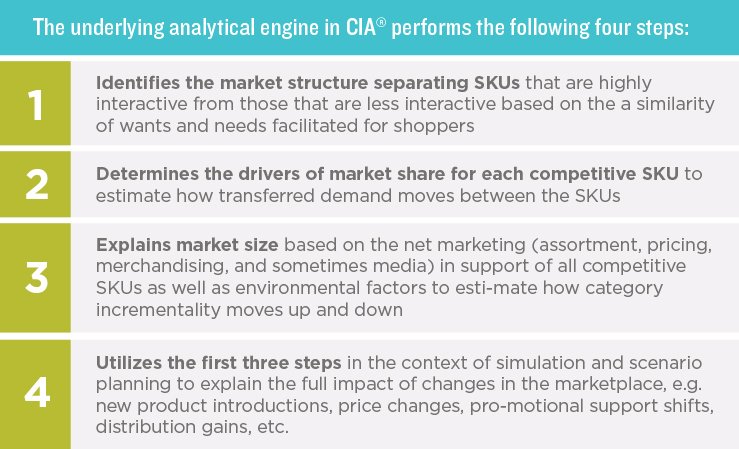
A key element of marketing is understanding how to positively influence the sales of your brand and negatively (and ethically) influence the sales of your competitors. The idea stretches from developing positioning statements to studying choice behavior or even addressing KPIs through metrics like market share. The underlying theme is that the assessment of marketing effectiveness requires both the absolute and relative viewpoint.
We call the relative viewpoint “competitive interaction analysis” or CIA®. However, addressing the relative viewpoint with analytics is significantly more detailed than generating a name. CIA® is about understanding the important dynamics of shopper response from a “wide-angle view” which is described in an earlier blog.
As we engage with clients, we find their preferred method of measuring the relative viewpoint is through econometric analysis and by establishing cross-elasticities. This involves tracking the unit sales of their products, observing the prices and promotional support of those items, doing the same for the competitors they think are relevant, and deriving cross-elasticities to explain the relationship. Unfortunately, this method frequently delivers incorrect answers.
In May 2007, I was invited to dinner at the home of Seenu Srinivasan, Adams Distinguished Professor of Management (Emeritus) at Stanford Graduate School of Business. I was able to ask why econometric analysis and the use of cross-elasticities were such a problem. Dr. Srinivasan explained that “the numbers are difficult to estimate since there are typically multiple competitive products that are applying numerous changes to their marketing mix all at once”.
Although the model-based approach to evaluating shopper response has revolutionized marketing efficiencies, it unfortunately ignores the portfolio approach to business management required to lead the marketing function today. However, these tables of elasticities and cross-elasticities fail to fully estimate how certain marketing actions will generate growth through category incrementality or simply produce transferred demand and cannibalize sales that would have been made anyway. Providing these answers was the whole reason for developing the CIA® modeling platform.
The essential benefit of the CIA® platform is that it sees your brand among all of the brands in the market … from the perspective of the shopper. You get insights into the holistic dynamics of the marketplace and foresights that produce correct answers a significant portion of the time. The desired outcome really isn’t new. For the past few decades, a portfolio-based approach has been at the heart of the category management and shopper insights initiatives. Middlegame is simply providing an analytical framework to expand beyond the tables of elasticities and cross-elasticities and offer a true decision support tool for marketing managers.
Middlegame is the only ROMI consultancy of its kind that offers a holistic view of the implications of resource allocation and investment in the marketplace. Our approach to scenario-planning differs from other marketing analytics providers by addressing the anticipated outcome for every SKU (your portfolio and your competitors) in every channel. Similar to the pieces in chess, each stakeholder can now evaluate the trade-offs of potential choices and collectively apply them to create win-win results.

